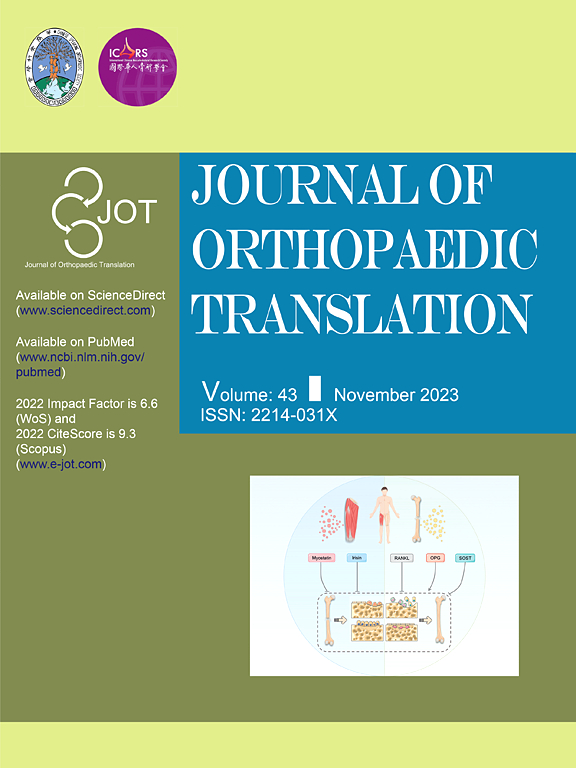Oncostatin-M functionalized cryogel microspheres for promoting diabetic bone defects regeneration
IF 5.9
1区 医学
Q1 ORTHOPEDICS
引用次数: 0
Abstract
Background/objective
Bone defects, especially those associated with diabetes, pose a significant challenge due to impaired healing capabilities. In situ bone tissue engineering harnesses the body's innate self-repair capabilities instead of introducing exogenous cells, and the development of biomaterials with well-designed biophysical and biochemical properties is pivotal for this strategy. Oncostatin M (OSM), a pleiotropic cytokine belonging to the IL-6 family, is responsible for recruiting endogenous cells and bone regeneration. This study focuses on the role of OSM in osteogenesis, angiogenesis, and immunoregulation, as well as developing OSM functionalized cryogel microspheres (OSM/MS) to enhance bone regeneration in diabetic conditions.
Methods
We systematically investigated the in vitro bioactivities of OSM on bone marrow mesenchymal stromal cells (BMSCs), human umbilical vein endothelial cells (HUVEC), and macrophages (RAW264.7). Subsequently, we fabricated OSM-loaded porous GelMA cryogel microspheres (OSM/MS) via the combination of emulsification and gradient freeze-crosslinking techniques. The biocompatibility, osteogenic and angiogenic potentials, and immunomodulatory effects of OSM/MS were evaluated in vitro. The in vivo efficacy of OSM/MS was assessed in an inflammatory diabetic rat calvarial defect model.
Results
50 ng/ml OSM can enhance migration and osteogenic differentiation of BMSCs, and angiogenesis in vitro without inciting an inflammatory response. OSM/MS, with an average diameter of ∼80 μm and an average pore size of about ∼10 μm, demonstrated excellent biocompatibility and significantly promoted the migration and osteogenic differentiation of BMSCs, as well as the angiogenic potential of HUVEC. Moreover, OSM/MS effectively regulated macrophage polarization towards an anti-inflammatory M2 phenotype. In vivo studies revealed that OSM/MS reduced osteoclast differentiation and promoted bone regeneration in diabetic rats.
Conclusion
The multifunctional properties of OSM/MS, including stem cell recruitment, osteogenesis, immunomodulation, and angiogenic induction, make it an effective approach for promoting bone regeneration in challenging diabetic conditions. This research not only lay the groundwork for the clinical utilization of OSM, but also presents a novel bioactive microsphere-based strategy for the management of diabetic bone defects.
The translational potential of this article
The ability of OSM/MS to promote endogenous stem cell recruitment, modulate the immune-osteogenesis microenvironment, and induce angiogenesis makes it a potent candidate for diabetic bone defects. The injectable and porous nature of OSM/MS facilitates minimally invasive delivery and integration with the irregular bone defect site. In particular, OSM/MS face fewer regulatory hurdles compared with traditional tissue engineering strategy due to the lack of cellular components. Given the significant unmet clinical need and the promising in vivo results, OSM/MS holds great potential for transforming the treatment paradigm for bone defects in diabetic patients.

肿瘤他汀- m功能化低温凝胶微球促进糖尿病骨缺损再生
背景/目的骨缺损,尤其是与糖尿病相关的骨缺损,由于其愈合能力受损,给骨缺损带来了重大挑战。原位骨组织工程利用人体固有的自我修复能力,而不是引入外源细胞,开发具有良好设计的生物物理和生化特性的生物材料是这一策略的关键。肿瘤抑制素M (OSM)是一种多效性细胞因子,属于IL-6家族,负责募集内源性细胞和骨再生。本研究的重点是OSM在成骨、血管生成和免疫调节中的作用,以及开发OSM功能化的低温凝胶微球(OSM/MS)来促进糖尿病患者的骨再生。方法系统研究OSM对骨髓间充质基质细胞(BMSCs)、人脐静脉内皮细胞(HUVEC)和巨噬细胞(RAW264.7)的体外生物活性。随后,我们通过乳化和梯度冷冻交联技术的结合制备了OSM负载的多孔凝胶微球(OSM/MS)。体外评价了OSM/MS的生物相容性、成骨和血管生成潜能以及免疫调节作用。在炎症性糖尿病大鼠颅骨缺损模型中评估了OSM/MS的体内疗效。结果50 ng/ml OSM能促进骨髓间充质干细胞的迁移、成骨分化和体外血管生成,但不引起炎症反应。OSM/MS的平均直径约为~ 80 μm,平均孔径约为~ 10 μm,具有良好的生物相容性,可显著促进BMSCs的迁移和成骨分化,并具有HUVEC的血管生成潜力。此外,OSM/MS有效调节巨噬细胞向抗炎M2表型的极化。体内研究表明,OSM/MS可减少糖尿病大鼠的破骨细胞分化,促进骨再生。结论OSM/MS具有干细胞募集、成骨、免疫调节和血管生成诱导等多种功能,是促进糖尿病患者骨再生的有效途径。本研究不仅为OSM的临床应用奠定了基础,而且为糖尿病性骨缺损的治疗提供了一种新的生物活性微球治疗策略。OSM/MS促进内源性干细胞募集、调节免疫成骨微环境和诱导血管生成的能力使其成为糖尿病性骨缺损的有力候选物。OSM/MS的可注射性和多孔性有利于微创输送和不规则骨缺损部位的整合。特别是,由于缺乏细胞成分,与传统的组织工程策略相比,OSM/MS面临的监管障碍更少。鉴于尚未满足的临床需求和有希望的体内结果,OSM/MS在改变糖尿病患者骨缺损的治疗模式方面具有巨大的潜力。
本文章由计算机程序翻译,如有差异,请以英文原文为准。
求助全文
约1分钟内获得全文
求助全文
来源期刊

Journal of Orthopaedic Translation
Medicine-Orthopedics and Sports Medicine
CiteScore
11.80
自引率
13.60%
发文量
91
审稿时长
29 days
期刊介绍:
The Journal of Orthopaedic Translation (JOT) is the official peer-reviewed, open access journal of the Chinese Speaking Orthopaedic Society (CSOS) and the International Chinese Musculoskeletal Research Society (ICMRS). It is published quarterly, in January, April, July and October, by Elsevier.
 求助内容:
求助内容: 应助结果提醒方式:
应助结果提醒方式:


